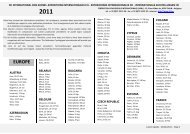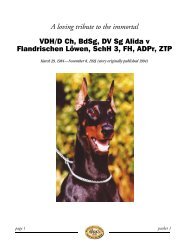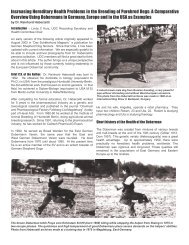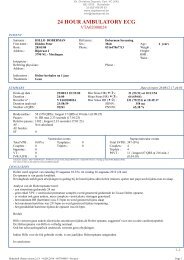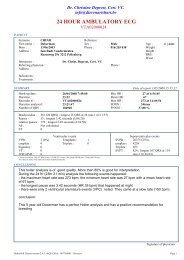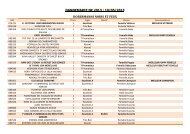Breeding Programme
Breeding Programme
Breeding Programme
Create successful ePaper yourself
Turn your PDF publications into a flip-book with our unique Google optimized e-Paper software.
Grade 1 is the mildest form where only tiny spots are seen on the back capsule of the lens. The spots are very<br />
difficult to see and a great skill and special equipment is needed. Some veterinarians argue the significance of<br />
few spots which causes differences in the statistics in different countries and among veterinarians. Since sight is<br />
not the most important sense in the dog, it can be assumed that only the most severe changes affect the dog’s<br />
quality of life (such as becoming more fearful).<br />
A realistic goal should be established that 35% of our population should be examined with a slit lamp (biomicroscope).<br />
By satisfying such a level, the affected population rate should drop to 25% and the incidence of cases within<br />
grades 2-6 would become more rare.<br />
Skin diseases<br />
Dobermanns are affected by many kinds of skin problems. However, as in other dog breeds, there could be several<br />
reasons for such conditions.<br />
Allergies and over-sensitive dogs may show symptoms through constant scratching. In some instances, these<br />
cases may be in a disease group which is easily seen but have difficulties in a diagnoses.<br />
Alopecia - hair defects and balding – are another form easily seen though still partly an unknown disease<br />
complex. Blue Dobermanns often suffer from this problem. There are other causes as well.<br />
Hormone disturbances such as hypothyroidism, can also show signs on a Dobermann‘s skin and hair coat.<br />
Demodex and staphylococcus infections sometimes tend to aggravate problems other than skin-classified<br />
diseases.<br />
Skin diseases almost always demand an individual’s thorough examination via blood tests, skin scrapings<br />
and biopsies. The correct treatment method will naturally depend on a precise diagnosis and the availability of<br />
viable existing treatment. However, in some cases like of blue Dobermanns balding, only alleviating managements<br />
are possible.<br />
Hypothyroidism<br />
It appears that the breed has a tendency to develop hypothyroidism like many other breeds. The clinical signs of<br />
the disease are both numerous and diverse:<br />
Varying types of skin problems, hormonal disturbances, obesity, lethargy, sensitivity to cold, loss of capacity<br />
to participate in hard exercise.<br />
Diagnosis is possible to be made by measuring thyroxine (T4) and thyroxine stimulating-hormone (TSH) levels<br />
from the blood. However, by only measuring thyroxine levels, misdiagnosis can occur since other diseases<br />
can also affect the values. As a treatment, replacement thyroxine is given in which the symptoms will typically<br />
subside or be controlled.<br />
Vestibular syndrome and other neurological problems<br />
Occasionally puppies are born that are restless, cry much, have difficulties in nursing and have neurological<br />
abnormalities. The disorder does not progress and if capable to suck, these puppies usually develop to normal<br />
individuals. The cause is unknown.<br />
Congenital vestibular disease is seen in young puppies with or without deafness. The puppies are affected<br />
from birth to 3-4 months of age and have head tilt, and difficulties in moving. The signs can disappear but the<br />
deafness if present is permanent. There is no treatment.<br />
Young and adult animals sometimes develop idiopatchic head tremor. There<br />
is a sudden up and down or side to side head movement. The dog is conscious<br />
and can move but there is no method to stop the tremor which normally lasts<br />
few minutes. The dog will not develop other neurological signs. The cause is<br />
unknown and there is no treatment.<br />
Panosteitis<br />
Fast growing, heavy-built, and strong-boned individuals have an increased risk<br />
of developing growth disturbances called panosteitis. Panosteitis is an acquired<br />
inflammatory condition of unknown etiology affecting long bones in front and/<br />
or hind legs causing limbing and pain. Nutritional disturbances and genetics<br />
can be involved.<br />
The diagnoses is based on an x-ray examination. The disease is self-limiting<br />
and the treatment includes correction of diet and anti-inflammatory medication.<br />
12 The Finnish Dobermann Club’s BREEDING PROGRAMME




